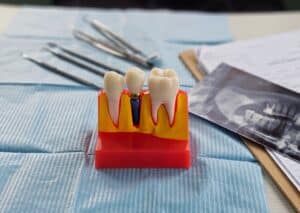When you visit your dentist for a six-month checkup and cleaning , you’ve probably noticed that the dental hygienist does a series of measurements before cleaning your teeth. What is going on and what is the value to your oral health?
The process is part of what is called dental charting (also called a periodontal chart), and it is an important tool for your dentist to help you maintain a healthy mouth.
After your dental appointment it’s best to incorporate the advice you’re given about maintaining healthy teeth and gums. And try to make sure you go back for regular checkups and charting.
Your dental chart
A dental chart is a graphical tool for organizing all the important information about your teeth and gums. Your hygienist, who checks the inside of your mouth, typically makes your dental chart.
By investigating your mouth, your hygienist gets information about your teeth and gums, and then makes notes on the chart about any important information that needs to be recorded.
The chart your hygienist produces can take a variety of forms. It is a graphical, or pictorial, representation of your mouth. It shows every tooth and includes spaces for making shorthand notes about the condition of your teeth and gums.
Reasons for dental charting
Your hygienist or dental assistant creates a dental chart of your mouth because it is a good way of organizing the important information about your dental health. By creating this chart, your dentist has all the information that they need to access your dental health, in one place in a simple format. They will update your chart every time you have a dental checkup so they can track the progress of your dental health.
Benefits of dental charting
There are many benefits to keeping a dental chart of your teeth and gums.
Benefits for your healthcare providers
They are able to keep an organized and easy-to-read record of the condition of your mouth.
They can refer back to this chart during future visits and compare your pocket depths.
They can update it to keep an accurate record of what is happening in your mouth.
Benefits for you
Your dentist is able to keep a good record of your health issues.
Your dentist is able to give you the best care possible and track your progress if you have issues that require treatment.
The chart gives both you and your dentist a point of reference to see if you are making progress in your dental health. With better home care gum pockets could improve.
What to expect during a dental charting
If you are making a first visit to a new dental office, you can expect that your hygienist will perform a complete dental charting of your mouth. You may only need a brief check of your mouth and an update of your chart during future visits. If you have problems that require treatment, you may need to get a full charting at your next checkup to track improvements.
Your hygienist will begin by counting and numbering your teeth on the chart. Any notable issues you have can then be assigned to the appropriate tooth and marked with a shorthand note on the chart.
Once your teeth are numbered, your hygienist will examine your teeth. They usually probe your gums to check the depths of your gum pockets (the area between the gum and the tooth that is measure in millimeters). And they will use an instrument to check the tops of your teeth for decay.
After your charting is complete, your hygienist will usually clean your teeth. Then your dentist will do an examination. If there is anything of concern marked on your chart, your dentist will investigate it more thoroughly.
Follow-up after a dental charting
After a regular checkup and a dental charting, your dentist will tell you what you need to do next. If there are issues of concern, your dentist will recommend things you can do at home, such as regular flossing, or using an electric toothbrush. They will probably also schedule another appointment for any procedures that are needed, like filling a cavity.
Source: Healthline.com


